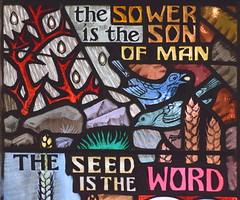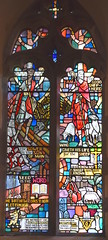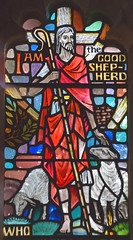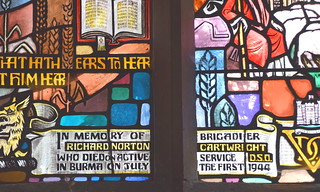| |
|
 |
|
Coming back to Ixworth
after almost twenty years away, I found that I
couldn't remember where the church was. Being too
lazy to get out my map, and not stupid enough to
use a satnav, I cycled up the long hill of that
remarkably good high street until I reached the
fire station at the top, and then I was back in
open country. Finally checking the map, I found
that the church was at the bottom of the hill.
Still, it didn't take long to get back there.
Ixworth is one of those small towns, or large
villages, that Suffolk seems to do so well. The
Bury St Edmunds to Diss and Stowmarket to
Thetford roads cross here, but both are now
carried past the village on bypasses, and so
Ixworth has the pleasant air of a relatively
remote and self-sufficient place, with a shop, a
post-office, a couple of decent pubs, and that
pre-requisite of modern rural civilisation, a
ladies' hairdresser. There's a super little water
mill on the road to Pakenham, actually in
Pakenham parish but closer to here. Ixworth is
not to be confused with Ixworth Thorpe, a tiny
hamlet a mile or two to the north, with a
stunning little thatched church, and especially
not with Ickworth, home of the Marquis of
Bristol, some ten miles to the south-west.
|
As I say, the church is immediately
beside the high street, but as it is concealed from it by
a row of shops and houses I felt vindicated for cycling
past it without noticing. A short driveway leads into a
small churchyard, out of which rises a big church, at
first sight all built on the eve of the Reformation. This
is pretty much the case, since the late 15th and early
16th century replaced everything except the porch and the
chancel, and there are even contemporary dates for the
completion of the tower. All that remained to be done
happened in that other great age of faith, the late 19th
century, when they replaced the chancel. All pieces of
the ensemble are fairly typical of their dates.
Look west of the church, and you can see the site of the
former Ixworth Priory. Most of this has now gone, but the
vaulted undercroft has been retained as part of the
current house on the site. There are more ruins visible
from the High Street further west.
You step into the feel of a thoroughly urban church, as
at Yoxford. This is partly a result of the rather
mediocre 1854 restoration, early for the century and
before people cared too much about rescuing old things,
hence the sombre replacement benches. But it is also to
do with the sheer size of St Mary, and perhaps that
serious east window too. The aisles are wide enough for
the nave to feel as broad as it is long. Towards the
west, the space beneath the tower has been converted into
a meeting room, all finished rather well in the early
1980s manner. Sam Mortlock tells us about something
rather fascinating we would be able to see inside the
meeting room if it wasn't locked. Several of the
dedicatory tiles that were set in the buttresses of the
newly-finished tower in the 16th century have been reset
here.
One of them is to a local man called Thome Vyal. I could
just make it out through the glass door. Mortlock tells
us that his will was proved in 1472, and he gave four
pounds to the steeple. The interesting thing about it is
that we know Vyal was a carpenter, so he probably worked
in this church, where no woodwork of the period survives,
but perhaps also at nearby Ixworth Thorpe, where much
does. Additionally, many of the churches round about here
are famous for their bench ends. Perhaps this suggests
that Ixworth might once also have had wonderful carvings
before the Victorian restoration.
The sombreness of the nave is barely enlightened by the
clerestory, and isn't helped by several heavy memorials
around the north doorway. But the lady chapel at the end
of the north aisle is rather sweet. In medieval times, it
was the chapel of the guild of St James, says Mortlock.
In any case, there is plenty of evidence of the busy life
of the parish, so the gloom doesn't weigh you down too
much.
The base of the roodscreen survives, and you step up
through it into the 19th century chancel. Now, this is
really serious - the great east window positively frowns
on you. But all this lightened by a gorgeous window of
1966 by Herbert Powell depicting the parables of the
Sower and the Good Shepherd, all very much in the
contemporary style of the day. There would be a loss of
nerve over the following half century from which stained
glass design is only now recovering from.
    
The east window is an early work by
the O'Connor Brothers of 1854, and is really rather
magnificent, showing two angels flanking the Good
Samaritan at the bottom, and a Crucifixion flanked by the
Resurrection and the Ascension. Clearly, the window is
before George Taylor took over the firm and rebuilt its
fortunes, and their earlier style is more harmonious than
it would become by the 1870s. Up in the sanctuary, the
Victorians reset the perky tomb of Richard Coddington.
Brasses of Coddington and his wife are set within a
semi-circular relief, and the tomb chest beneath glows
with heraldry.
Coddington was not from Suffolk at all, and could never
have expected to end up buried here. However, when the
monasteries were suppressed in the 1530s, Henry VIII
offered the estate and lands of Ixworth Priory to
Coddington in exchange for the village he owned near
Ewell in Surrey. This was good business for Coddington,
but unfortunate for the villagers of the little
settlement of Cuddington, because Henry had their houses
and church erased from the map.
| In their place, he built
the massive pile of Nonesuch Palace, the largest,
grandest and most highly decorated single
construction in England during the course of the
16th century. It was furnished with all the great
riches that continental Europe had to offer. It
was surrounded by an amazing park, woodlands and
rides. I suppose that it is good to know that the
irreplaceable treasures of the English medieval
church weren't all frittered away on pointless
and fruitless sieges of French coastal towns. Nonesuch Palace no longer exists.
When the English royal family could no longer
keep itself in the manner to which it had become
accustomed, the house was demolished for building
materials. This seems to have taken a
considerable time, for destruction began in the
1680s, but at least one of the towers was still
standing in the early 18th century. Oliver
Cromwell himself had overseen the selling off of
the contents during the Commonwealth, and his
parliament had ordered the cutting down of most
of the trees for shipbuilding. Hardly a memory
survives today. But Richard Coddington lies here,
probably still feeling quietly pleased with
himself.
|
|
 |
|
|
|

